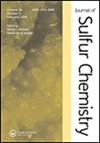纳米磁性NH2·MIL-101(Fe)/ED作为合成硫吡喃和氧螺吲哚啉硫吡喃衍生物的新型高效催化剂
IF 2.1
3区 化学
Q3 CHEMISTRY, MULTIDISCIPLINARY
引用次数: 0
摘要
在这篇文章中,我们报道了一个基于mof的高效催化体系,用于合成硫吡喃和氧硫吡喃-吲哚啉硫吡喃衍生物。首次将FeCl3锚定在CoFe2O4磁性纳米颗粒表面合成磁性NH2.MIL-101(Fe)/ED,然后用2-氨基对苯二甲酸形成MOF结构。在最后一步,用乙二胺(ED)修饰金属中心。采用傅里叶透射红外光谱、x射线衍射、场发射扫描电镜、透射电镜、布鲁诺尔-埃米特-泰勒分析和热重分析等技术对催化剂结构进行了表征。用x射线晶体学测定了最终产物的结构。纳米磁性NH2.MIL-101(Fe)/ED给了我们一个满意的答案,提供了相应的产品高至优异的产率(高达93%)。在其他可用的程序中,该催化系统提供了更高的最终产品收率,这是由于该合成催化剂的优越活性。设计一种高效的碱性金属有机骨架催化剂。基于mof的新型催化体系可扩展和高产合成硫吡喃和氧吡喃-吲哚啉硫吡喃衍生物。易于访问重要的构建模块类。简单的处理程序,干净的反应曲线和优异的产品收率。图形抽象本文章由计算机程序翻译,如有差异,请以英文原文为准。
Nanomagnetic NH2·MIL-101(Fe)/ED as a new highly efficient catalyst for the synthesis of thiopyran and oxospiro-indolinethiopyran derivatives
In this publication, we reported an efficient MOF-based catalytic system for the synthesis of thiopyran and oxospiro-indolinethiopyran derivatives. For the first time, magnetic NH2.MIL-101(Fe)/ED was synthesized through anchoring FeCl3 on CoFe2O4 magnetic nanoparticles surface and then 2-aminoterphthalic acid was used to form MOF structure. In the final step, metal centers were modified with ethylenediamine (ED). Different techniques such as Fourier transmission infrared spectroscopy, X-ray diffraction, Field emission scanning electron microscopy, Transmission electron microscopy, Brunauer–Emmett–Teller analysis, and Thermogravimetric analysis were used to characterize the catalyst structure. Also using X-ray crystallography, the structure of the final product was determined. Nanomagnetic NH2.MIL-101(Fe)/ED gave us a satisfactory answer, affording the corresponding products with high to excellent yields (up to 93% yield). It seems that among the other available procedures, this catalytic system provided higher final product yields which result from the superior activity of this synthesized catalyst.
Highlights
- Designing an efficient basic metal-organic framework catalyst.
- Novel MOF-based catalytic system for scalable and high-yielding synthesis of thiopyran and oxospiro-indolinethiopyran derivatives.
- Easy access to important classes of building blocks.
- Simple work-up procedure, clean reaction profiles and excellent product yields.
求助全文
通过发布文献求助,成功后即可免费获取论文全文。
去求助
来源期刊

Journal of Sulfur Chemistry
CHEMISTRY, MULTIDISCIPLINARY-
CiteScore
4.10
自引率
9.10%
发文量
38
审稿时长
6-12 weeks
期刊介绍:
The Journal of Sulfur Chemistry is an international journal for the dissemination of scientific results in the rapidly expanding realm of sulfur chemistry. The journal publishes high quality reviews, full papers and communications in the following areas: organic and inorganic chemistry, industrial chemistry, materials and polymer chemistry, biological chemistry and interdisciplinary studies directly related to sulfur science.
Papers outlining theoretical, physical, mechanistic or synthetic studies pertaining to sulfur chemistry are welcome. Hence the target audience is made up of academic and industrial chemists with peripheral or focused interests in sulfur chemistry. Manuscripts that truly define the aims of the journal include, but are not limited to, those that offer: a) innovative use of sulfur reagents; b) new synthetic approaches to sulfur-containing biomolecules, materials or organic and organometallic compounds; c) theoretical and physical studies that facilitate the understanding of sulfur structure, bonding or reactivity; d) catalytic, selective, synthetically useful or noteworthy transformations of sulfur containing molecules; e) industrial applications of sulfur chemistry; f) unique sulfur atom or molecule involvement in interfacial phenomena; g) descriptions of solid phase or combinatorial methods involving sulfur containing substrates. Submissions pertaining to related atoms such as selenium and tellurium are also welcome. Articles offering routine heterocycle formation through established reactions of sulfur containing substrates are outside the scope of the journal.
 求助内容:
求助内容: 应助结果提醒方式:
应助结果提醒方式:


